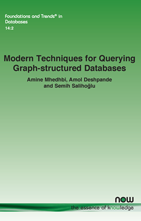Modern Techniques For Querying Graph-structured Databases
By Amine Mhedhbi, Polytechnique Montréal, Canada, amine.mhedhbi@polymtl.ca | Amol Deshpande, University of Maryland, USA, amol@umd.edu | Semih Salihoğlu, University of Waterloo, Canada, semih.salihoglu@uwaterloo.ca
Abstract
In an era of increasingly interconnected information, graph-structured data has become pervasive across numerous domains from social media platforms and telecommunication networks to biological systems and knowledge graphs. However, traditional database management systems often struggle when confronted with the unique challenges posed by graph-structured data, in large part due to the explosion of intermediate results, the complexity of join-heavy queries, and the use of regular path queries.
This survey provides a comprehensive overview of modern query processing techniques designed to address these challenges. We focus on four key components that have emerged as pivotal in optimizing queries on graph-structured databases: (1) Predefined joins, which leverage precomputed data structures to accelerate joins; (2) Worst-case optimal join algorithms, that avoid redundant computations for queries with cycles; (3) Factorized representations, which compress intermediate and final query results; and (4) Advanced techniques for processing recursive queries, essential for traversing graph structures. For each component, we delve into its theoretical underpinnings, explore design considerations, and discuss the implementation challenges associated with integrating these techniques into existing database management systems. This survey aims to serve as a comprehensive resource for both researchers pushing the boundaries of query processing and practitioners seeking to implement state-of-the-art techniques, in addition to offering insights into future research directions in this rapidly evolving field.
Modern Techniques For Querying Graph-structured Databases
In an era of increasingly interconnected information, graph-structured data has become pervasive across numerous domains, from social media platforms and telecommunication networks to biological systems and knowledge graphs. However, traditional database management systems often struggle when confronted with the unique challenges posed by graph-structured data, in large part due to the explosion of intermediate results, the complexity of join-heavy queries, and the use of regular path queries.
This monograph provides a comprehensive overview of modern query processing techniques designed to address these challenges. Four key components that have emerged as pivotal in optimizing queries on graph-structured databases are focused on, namely: (1) Predefined joins, which leverage precomputed data structures to accelerate joins; (2) Worst-case optimal join algorithms, that avoid redundant computations for queries with cycles; (3) Factorized representations, which compress intermediate and final query results; and (4) Advanced techniques for processing recursive queries, essential for traversing graph structures. For each component, theoretical underpinnings are covered and design considerations are explored, and implementation challenges associated with integrating these techniques into existing database management systems are discussed. This monograph aims to serve as a comprehensive resource for both researchers pushing the boundaries of query processing and practitioners seeking to implement state-of-the-art techniques, in addition to offering insights into future research directions in this rapidly evolving field.
